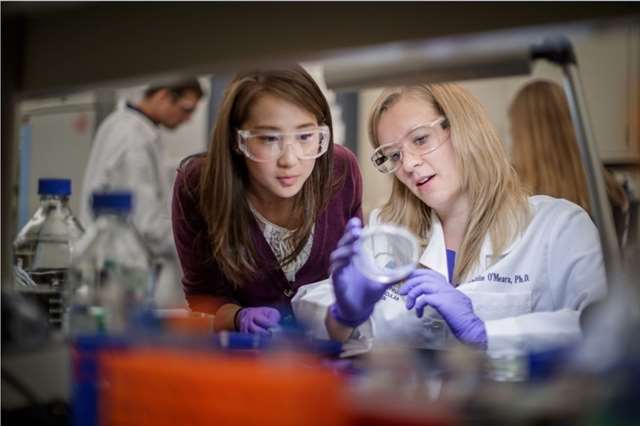National Institutes of Health Awards $2.4 Million Grant to Cross-Disciplinary Team of Researchers to Study Psychedelics for Methamphetamine Addiction
Milwaukee, Aug. 27, 2024 – John McCorvy, PhD, Assistant Professor in the Department of Cell Biology, Neurobiology, and Anatomy at the Medical College of Wisconsin (MCW); Adam Halberstadt, PhD, Professor of Psychiatry at the University of California San Diego (UCSD) and Director of the UCSD Center for Psychedelic Research; and Kevin Murnane, PhD, Associate Professor of Pharmacology, Toxicology, and Neuroscience and Director of Basic Science Research for the Louisiana Addiction Research Center at LSU Health Shreveport, were recently awarded a five-year, $2.4 million research grant from the National Institute on Drug Abuse (NIDA), part of the National Institutes of Health (NIH), to uncover critical insights into how psychedelics could be used as a therapeutic to treat methamphetamine addiction.
Stimulant use disorder and methamphetamine-related overdose deaths are escalating at an alarming rate. According to data from NIDA, the number of overdose deaths in the United States involving psychostimulants (primarily methamphetamine) has grown significantly since 2015 when there were 5,716 attributed deaths. In 2022, NIDA reported 34,022 overdose deaths involving psychostimulants – a nearly 500% increase from 2015 to 2022.
Psychedelic substances, like psilocybin, have shown promise in treating a wide range of behavioral health conditions, including anxiety, depression, alcoholism, and nicotine dependence. However, these substances interact with multiple receptors and are not specifically selective for the serotonin 5-HT2A receptor, which is vital for their psychoactive effects. The research spearheaded by Drs. McCorvy (MCW), Halberstadt (UCSD), and Murnane (LSU) seeks to understand the specific role of 5-HT2A receptor signaling in mitigating the effects of methamphetamine use.
“There are currently no pharmacological treatments for methamphetamine addiction. Our research aims to unravel the precise mechanisms through which psychedelics influence the 5-HT2A receptor – understanding that could lead to lessening their psychoactive effect and open the door to new treatments,” said Dr. McCorvy. “This project’s findings could ultimately pave the way for new therapeutic approaches to treat stimulant use disorder, impacting the lives of so many who are coping with addiction.”
The significance of this research extends beyond the immediate goal of finding new treatments for methamphetamine addiction. Understanding which serotonin receptors facilitate the beneficial effects of psychedelics can pave the way for developing targeted therapies that minimize psychedelic effects, potentially allowing for daily or regular use without impairing the patient’s daily life.
As Dr. Halberstadt noted, “Psychedelics appear to have significant therapeutic activity against different types of substance abuse and other psychiatric disorders. However, existing psychedelics induce intensive psychoactive effects and can also induce side-effects in some individuals, complicating the clinical use of these substances and restricting their widespread application. Our project seeks to understand the mechanism for the therapeutic effects of psychedelics against methamphetamine addition, potentially enabling development of a new generation of molecules with effects that are much more manageable and better tolerated.”
As Dr. Murnane noted, “For methamphetamine addiction, the current standard of care involves behavioral treatments with limited success rates over multiple cycles of therapy. This creates a public health imperative to research new and deliver effective therapies for methamphetamine addiction. This research project will advance psychedelics as a promising new treatment option based on reported data in initial clinical studies, as well as our own preliminary research. It will also unlock understanding into key physiological mechanisms that drive methamphetamine addiction, as well as therapeutic response mechanisms, allowing the development of second-generation serotonin agents with improved profiles.”
NIDA recently solicited grant applications for innovative research projects that employ psychedelics for drug addiction. This project – Investigations into 5-HT2A signaling mechanisms of psychedelic drugs for the treatment of stimulant use disorder – was one of only two non-clinical trial grant applications selected for funding by NIDA.
“We’re thrilled to receive this first-of-its-kind funding from NIDA to conduct such unique and innovative research. It not only validates our approach to studying psychedelics but highlights the urgent need for new treatments for methamphetamine addiction,” said Dr. McCorvy. “Our goal is to leverage cutting-edge chemical biology tools to unravel the specific mechanisms by which psychedelics exert their effects, potentially leading to novel therapies that can significantly impact public health.”
This research is timely and crucial given the alarming rates of methamphetamine overdoses, especially in the southern and western United States where methamphetamine was the most common drug in overdose deaths in 2017, surpassing those from opioid overdoses. The study’s findings could lead to novel, effective treatments for a problem that has long lacked viable medical solutions.
Keep up with the latest news. Sign up for Newsroom Alerts.
Latest press releases, stories and resources.
MCW Media Contacts
The media relations team at MCW is happy to assist in coordinating experts for interviews. Please reach out to us at:
media@mcw.edu
(414) 955-8764
Contact us


